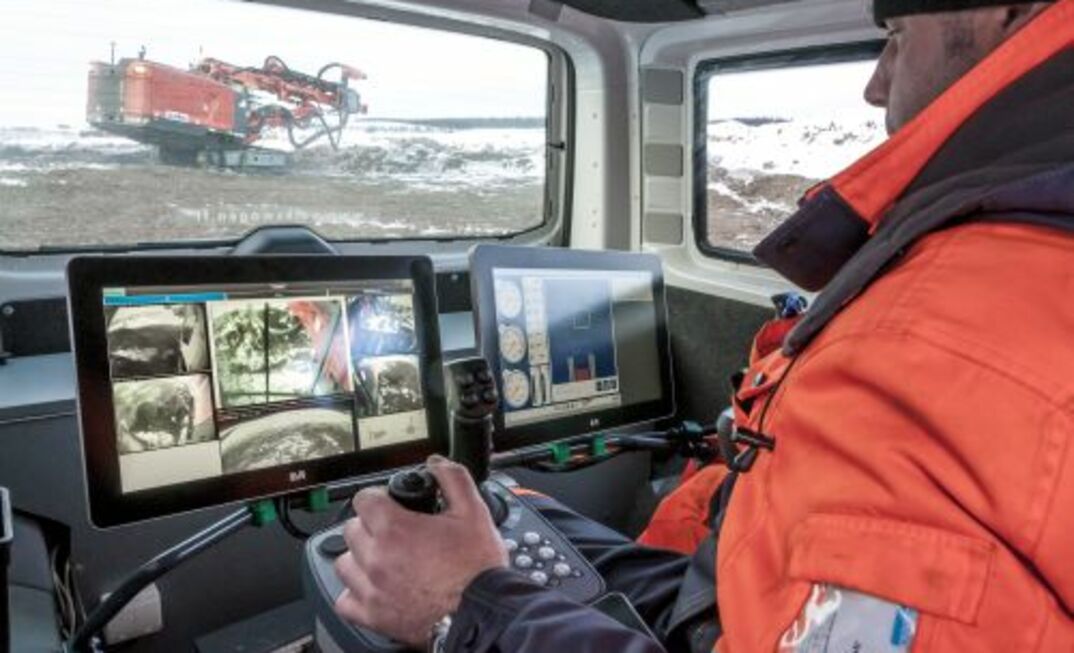Last year, Sandvik expanded its suite of AutoMine automation products, showcasing its AutoMine Surface Drilling, which applies the technology and experience used to develop its underground automated mining systems. AutoMine Surface Drilling is available with the company’s existing DPi series of surface drill rigs.
While a handful of companies specialise in automated technology for the mining industry, it’s easy to see why Sandvik’s suite of autonomous surface drilling products are a force to be reckoned with.
The company has two types of surface drills.
There is the top hammer offering in the company’s DPi range, which solely provides remote-controlled drilling, then there are the down-the-hole (DTH) and rotary versions, with three levels of automation.
The rotary and DTH range has been available for about three months and according to Sandvik Mining’s Australian product support manager for mining system Pieter Prinsloo, the equipment is proving to be quite the hit.
“There is a lot of interest,” he told MiningNewsPremium.net, adding it recently had three orders for a specific drill type with the automation attachment.
The DTH and rotary versions have three tiers of operation. Prinsloo said the equipment could be set up to operate under any of the three tiers when a customer ordered the drills or when the retrofits were required on machines not older than 5000 operating hours.
Tier three is the most advanced offering and fully automated. It involves the operator being placed in a separate control room in a command centre, enabling the operator to carry out the same tasks as conventional manual operation, but without the potential hazards and health risks.
“The wireless network connection provides continuous, reliable real-time video and data communication between the drill rig and the operator station,” Prinsloo said.
Prinsloo said the cameras, including a remote controlled pan-tilt-zoom camera for drilling, rod-handling and tramming controls, transmitted real time images on the operator station’s displays, helping to eliminate blind spots in the drilling area.
As for the top hammer, Prinsloo said it provided improved safety and efficiency for surface drilling operations.
“The system records production data as well as conditioning monitoring data,” he said.
The technology is best applied when drilling is required close to dangerous hanging walls or drilling over voids, in other words places which you normally don’t want human life being near.
Improved visibility is another key feature, with the line of sight feature meaning there is somebody sitting close to the machine adding line of sight.
Additionally, the data monitoring and recording is quite advanced compared to other products on the market.
“You can basically monitor conditions such as your fuel usage, engine temperature, hydraulic oil pressure etc,” he said.
“You can log and review all the alarms.”
For example, if there is an over temperature or under pressure alarm on the drill, then it all gets logged on the system and clients have access to that specific information.
The product has been released in Finland and Sweden and so far the reception has been positive.
“There is a lot of focus around the safety aspects of the system and what it will allow customers to do,” Prinsloo said.
“There is a lot of enthusiasm…especially as a result of the reporting features and data recording, and the options to remove operators from the drills under dangerous conditions such as unstable high walls and drilling over voids.”
Prinsloo said eventually, all Sandvik’s AutoMine products would utilise the same control system technology.
“We are migrating the rotary and the DTH onboard communication CAN technology to also be the same as the underground [automation mining systems],”he said.
“That will improve spare parts, visibility, price of components and operating costs.”
Companies operating in Australia will have to wait a little but longer to get their hands on the recently launched top hammer drill range however.
With the prototype development complete, Sandvik hopes to release the product to the Australian market at the end of July.
While orders for Sandvik’s automated technology have increased significantly, Prinsloo believes it’s the surface drilling market that has experienced the lion’s share of the growth.
“The risk in surface [automation drilling] is perceived to be lower than it is in underground even though the underground industry is very mature and is a very successful product,” he said.
“Underground mines are slowing exploring into the automation space from a Sandvik perspective.”
While automated drilling is not new to industry, Prinsloo said some people still had an aversion to it due to various misconceptions.
“Sometimes people can be reluctant to take the technology on board and work with it because of the perception automation has on the workforce, but it is all about people management at the end of the day,” he said.
Prinsloo said while some workers felt threatened by automation it was unfounded because at the end of the day they were working in a much safer environment.
And the belief that autonomy results in job losses is another misunderstanding.
“The negativity around the impact of automation is a misconception because while you might need to have less operators with their hands on the equipment you are still going to need people to manage the maintenance and do regular inspections,” he said.
“Automation is about improving efficiencies and operating equipment under optimal performance conditions.
“There will always be human interaction.”
Enhanced safety, accuracy of drilling pattern, longer utilisation hours and data collection and analysis for production and condition monitoring were just some of the key components of automation that could assist in improvements in productivity and safety.
While Prinsloo admits there are people that “absolutely support it [automation] and people who are totally against it”, he urged companies to consider the bigger picture when choosing between automation and the alternative.
“It is important for mines to consider automation during their planning and development stages as it makes the implementation process much easier if mines were developed with automation in mind,” he said.
While Sandvik, like its competitors, is working hard to gain dominance in the automation space, Prinsloo said it was at times difficult to attract new customers.
“It’s difficult for different original equipment manufacturers to compete in the same space as other OEMS that have preference with a customer,” he said.
But Sandvik has an advantage as its technology goes beyond reliability, safety and operating cost reductions.
“Sandvik’s automation system is the only system in Australia that is as61508 compliant, and we have done a lot of work together with consultants, customers and legislators to achieve standards compliance,” Prinsloo said.
“Fully autonomous rod changing is a feature that no other competitor offers.”
























